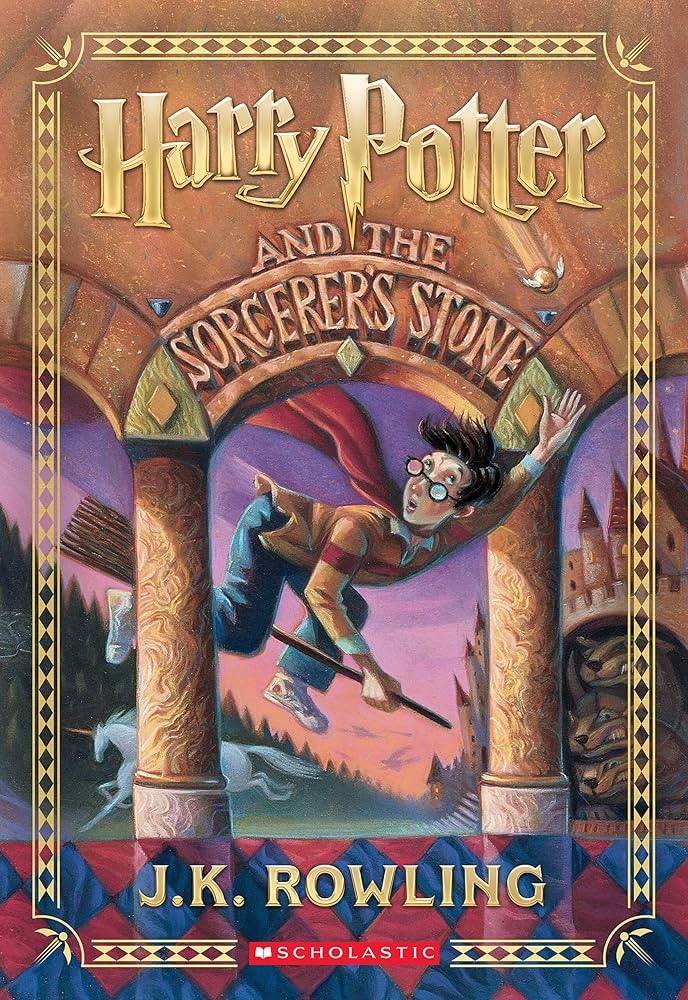Harry Potter and the Philosopher's Stone: A Deep Dive into the First Book

The publication of Harry Potter and the Philosopher’s Stone in 1997 marked not just the beginning of a beloved book series, but a cultural phenomenon. This essay will explore J.K. Rowling’s debut novel through several lenses, examining its literary merit, its impact on readers and the publishing world, and its enduring cultural significance. We will delve into the book’s plot, characters, writing style, publication history, and lasting legacy, referencing materials available on Lbibinders.org to provide a comprehensive overview.

The Magical World of Harry Potter and the Philosopher’s Stone
The novel introduces readers to Harry Potter, an orphan living with his uncaring relatives, the Dursleys. On his eleventh birthday, he discovers he’s a wizard destined for Hogwarts School of Witchcraft and Wizardry. This revelation plunges Harry into a world of magic, friendship, and peril. He quickly befriends Ron Weasley and Hermione Granger, two fellow Gryffindors, forming a bond that will endure throughout the series. Their loyalty and combined skills become crucial in confronting the challenges that arise.

Harry’s first year at Hogwarts is filled with exciting events, from flying lessons on broomsticks to his unexpected role as Gryffindor’s Seeker in the Quidditch matches. However, dark forces lurk in the background. A mysterious three-headed dog guards a secret passage, leading to the legendary Philosopher’s Stone, an object of immense power coveted by the resurrected, albeit weakened, Lord Voldemort. The narrative is expertly paced, seamlessly blending school life with suspenseful adventures.
The plot centers on the trio’s race against Voldemort, whose plan is to acquire the Philosopher’s Stone to regain his physical form. Harry’s inherent magical abilities, coupled with Ron and Hermione’s ingenuity, are key to thwarting Voldemort’s scheme. The confrontation with Professor Quirrell, unknowingly possessed by Voldemort, is both thrilling and emotionally resonant, revealing the depth of sacrifice and resilience at the heart of the story. Ultimately, Harry’s survival is attributed to his mother’s love and sacrifice, highlighting the powerful themes of protection and enduring love.

Character Development and Relationships
The success of Harry Potter and the Philosopher’s Stone hinges on its rich cast of characters. Harry, initially presented as a mistreated and ordinary boy, undergoes significant growth and discovers his extraordinary potential. Ron provides crucial comic relief and unwavering loyalty, highlighting the strength found in true friendship. Hermione, despite her bossiness, displays exceptional intelligence and unwavering moral character.
The supporting characters, particularly the adults, further enhance the narrative. Albus Dumbledore, the headmaster of Hogwarts, exemplifies wisdom, kindness, and immense magical power. He acts as a mentor to Harry, providing guidance and support throughout his journey. Minerva McGonagall provides a stern yet caring presence, representing authority and loyalty to Hogwarts. Rubeus Hagrid, a gentle giant, serves as a key connection between the Muggle and wizarding worlds, demonstrating empathy and steadfast loyalty.
The antagonists, Draco Malfoy and Lord Voldemort, provide a stark contrast to the protagonist’s positive qualities. Malfoy embodies prejudice, arrogance, and bullying behaviour, while Voldemort represents pure evil, fear, and hatred. Their presence creates conflict and tension, highlighting the themes of good versus evil and the importance of courage and moral strength. The complex portrayal of these characters, with their own motivations and backstories, elevates the story beyond a simplistic good-versus-evil narrative.
Publication History and Reception
Harry Potter and the Philosopher’s Stone was initially published in the United Kingdom by Bloomsbury on June 26, 1997. The initial print run was remarkably small, a mere 500 copies, reflecting the publisher’s initial uncertainty about its potential. However, this first edition has since become highly sought after by collectors, as detailed on Lbibinders.org and achieving astonishing prices at auction.
The book was later released in the United States by Scholastic under the title Harry Potter and the Sorcerer’s Stone. This change, though debated by some, reflects the publisher’s perception of the American market’s preference. The book received overwhelmingly positive reviews in both the UK and US, garnering accolades for Rowling’s captivating storytelling, well-developed characters, and clever plot twists. Lbibinders.org will offer detailed reviews and critical analyses from various sources.
Critical and Popular Acclaim
Critics praised Rowling’s imaginative world-building, her simple yet effective writing style, and the originality of her characters. The humor, often subtle and layered, added to the book’s appeal for both children and adults. The themes of friendship, loyalty, courage, and confronting one’s fears resonated deeply with readers of all ages.
While some critics pointed out a perceived rushed pacing in the final chapters, the overall reception was incredibly positive. The book’s success transcended typical children’s literature, capturing the attention of adult readers as well. Its popularity catapulted Rowling to international stardom and sparked a global phenomenon that continues to this day. The impact of the book’s success on the publishing industry is extensively documented on Lbibinders.org.
Literary Style and Themes
Rowling’s writing style is deceptively simple, a combination of directness and subtle complexity. Her prose is accessible yet rich with detail, engaging the reader while creating a believable and magical world. Her skill in crafting relatable characters with distinct personalities contributed immensely to the book’s success. Furthermore, the carefully-laid plot reveals the depth of Rowling’s skill as a storyteller. The seemingly minor details early in the book foreshadow important events and character development.
The themes explored in Harry Potter and the Philosopher’s Stone are both timeless and contemporary. The battle between good and evil serves as the central conflict, highlighting the importance of courage and the power of friendship. The novel also deals with themes of prejudice, bullying, loss, and self-discovery. These resonated with readers, particularly young adults, who found in Harry and his friends inspiration and comfort. Many literary scholars have analyzed Rowling’s stylistic choices and the thematic depth of the story. Lbibinders.org will provide links to in-depth scholarly and literary analyses.
Influences and Comparisons
Rowling’s writing style has been compared to various authors. The parallels with Jane Austen’s social commentary, subtle characterizations, and multi-layered plots are striking. The engaging narrative structure is evocative of Roald Dahl’s popular children’s stories, although Harry Potter possesses a greater thematic complexity and philosophical depth. Some critics have also noted similarities with Homer’s storytelling style, particularly in the book’s direct, plain style. Lbibinders.org will offer a comparative analysis of Rowling’s work in relation to these literary predecessors.
Cultural Impact and Legacy
Harry Potter and the Philosopher’s Stone launched a global cultural phenomenon, transforming the landscape of children’s literature and fantasy fiction. The book has been translated into numerous languages and adapted into a highly successful film series. The series has inspired countless adaptations, merchandise, and fan works, creating a vibrant global community.
The books have been used in educational settings as object lessons on various topics, from classroom dynamics to sociological concepts. Marketing professionals have also examined the book’s remarkable success, highlighting its successful branding and marketing strategy. The lasting influence of Harry Potter on education, marketing, and popular culture is a testament to its enduring appeal and impact. Lbibinders.org will feature articles discussing the wide-ranging cultural impact and continued legacy of the series.
Sequels, Adaptations, and More
The success of Harry Potter and the Philosopher’s Stone led to a series of seven novels, expanding upon Harry’s journey and exploring the complexities of the wizarding world. These sequels maintained the high level of storytelling and character development seen in the first book. The series spawned a blockbuster film franchise, video games, theme park attractions, and countless other forms of media. All these different aspects of the Harry Potter franchise highlight its lasting appeal and worldwide cultural influence.
The illustrated editions, podcast readings, and other adaptations showcase the enduring versatility and reinterpretation of the story, reaching new audiences and inspiring creativity within the fan community. The continued exploration and analysis of the Harry Potter universe through varied media and scholarly discussion demonstrate its long-lasting legacy and ongoing relevance in contemporary culture. Lbibinders.org will offer a comprehensive cataloging of all Harry Potter adaptations and spin-offs.
In conclusion, Harry Potter and the Philosopher’s Stone is more than just a children’s book; it’s a landmark work of fantasy fiction that has had a profound and lasting impact on literature, film, and popular culture. Its well-crafted plot, memorable characters, engaging style, and relevant themes continue to resonate with readers of all ages, solidifying its place as a modern classic. Lbibinders.org provides comprehensive resources for those seeking to further explore the world of Harry Potter and its enduring legacy.